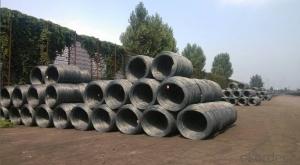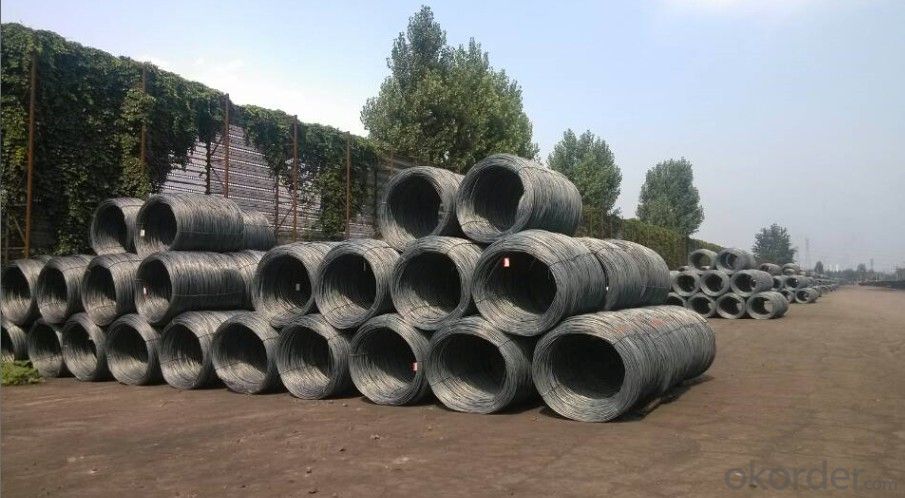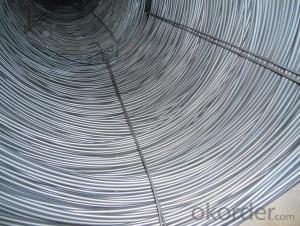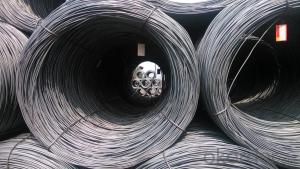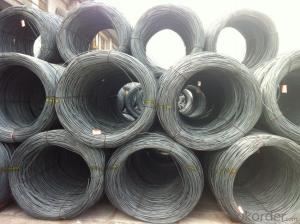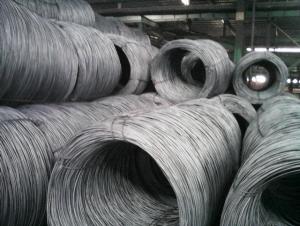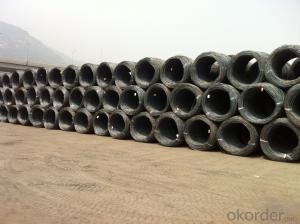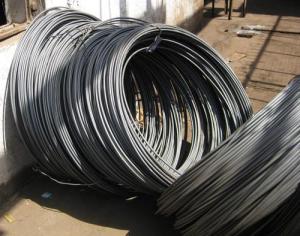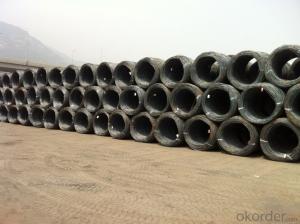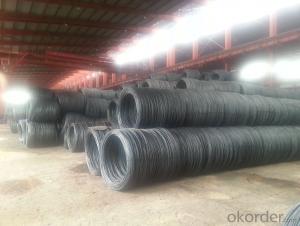Steel Wire Rods High Carbon Hot Rolled First Class Quality Best Seller
- Loading Port:
- Tianjin
- Payment Terms:
- TT OR LC
- Min Order Qty:
- 500 m.t.
- Supply Capability:
- 30000 m.t./month
OKorder Service Pledge
OKorder Financial Service
You Might Also Like
1.Structure of Wire Rod Steel for Construction Description
Wire rod steel is widely used for commercial building structure, pre-engineering buildings, machinery support structures, prefabricated structure, medium scale bridges and so on. We have supplied this product for many years and gained widespread reputation.
2.Main Features of the Wire Rod Steel for Construction
fasteners, bolts, rivets, screws,
general purpose wires,
electrode wires, industrial wires, agriculture wires,
bush wires, chain rivet wires,
detonator wire,
Umbrella ribs, upholstery wires, cycle spokes, needle wires, heald wires, staple pin Wire, safety pin wires
ACSR wires, earth wires,
tyre and hose reinforcement wires,
prestressed concrete wire, springs and rope wires,
card clothing wires,
vineyard wires,
ball bearing quality
Automobile parts like screw, fasteners, bush, spline, socket, connecting rod, shaft, gear, rivets, engine shaft, connecting rod, spindles, gears, etc.
3.Wire Rod Steel for Construction Images
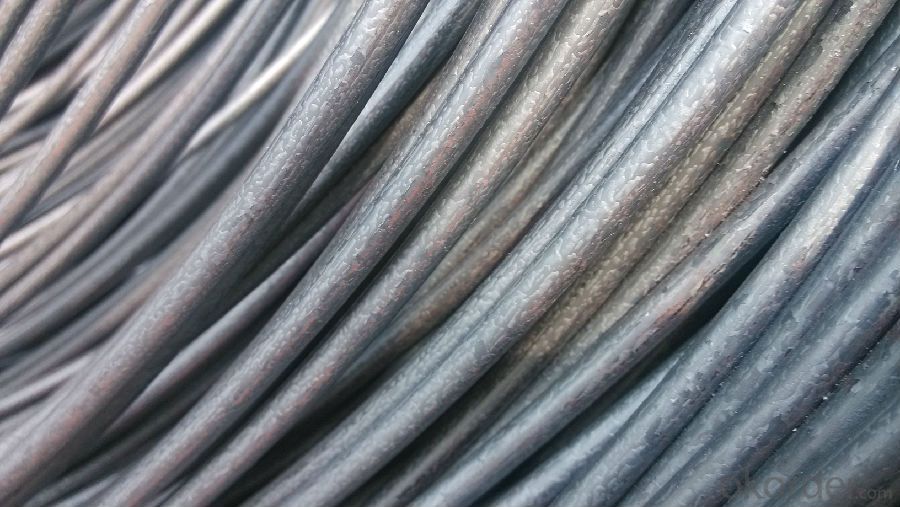
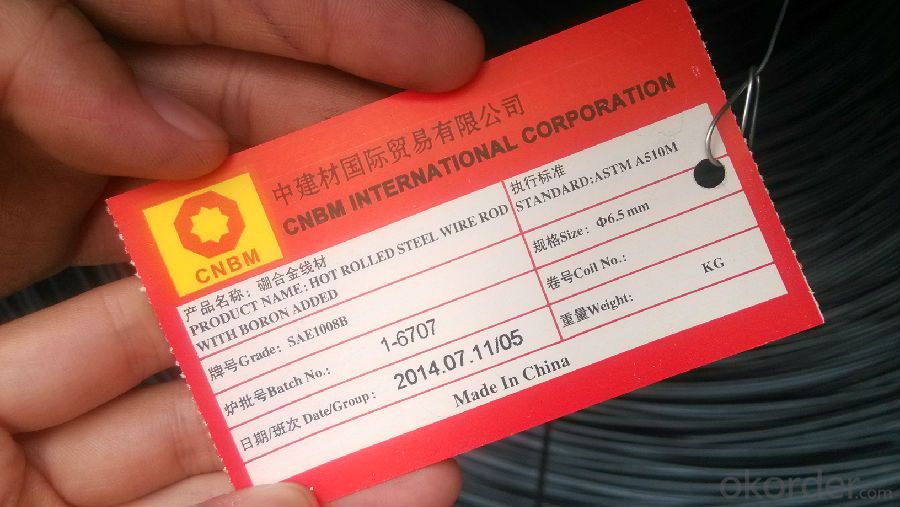
4.Wire Rod Steel for Construction Specification
Grade | Chemical Composition(%) | |||||
C | Mn | Si | P | S | B | |
SAE1008B | 0.10Max | 0.3-0.5 | 0.15Max | 0.040Max | 0.050Max | 0.0008Min |
Mechanical Properties | ||||||
Yield strength(N/mm2) | Tensile strength (N/mm2) | Elongation(%) | ||||
≥195 | 315-430 | ≥30 | ||||
Grade | Chemical Composition(%) | |||||
C | Mn | Si | P | S | B | |
SAE1006B | 0.03-0.07 | ≤0.32 | ≤0.30 | ≤0.040 | ≤0.045 | >0.0008 |
Mechanical Properties | ||||||
Yield strength(N/mm2) | Tensile strength(N/mm2) | Elongation(%) | ||||
≥195 | 315-430 | ≥30 | ||||
5.FAQ of Wire Rod Steel for Construction
We have organized several common questions for our clients,may help you sincerely:
1.What is your minimum order quantity ?
Our MOQ is 500mt for each size. And we will consider to give more discount if you make big order like 10000 tons and more. Further more, the more appropriate payment term your offer the better price we can provide.
2.Please tell me the daily output and wire rod mill’s brand ?
Our daily output is 4000mt/day and our rolling mill from Germany’s SMS MEER
3.Which countries are your main sales?
Thanks to the professional international trade team, solid distribution channel and long – term cooperation customers, our market share in overseas realizes a tremendous growth, now we already became a main player in Middle East and South East Asia. Meanwhile, we are also the biggest supplier of Pre-painted galvanized steel coil in Philippines, Saudi Arabia, United Arab Emirates, Iran, Sudan etc.
- Q: What are the different types of steel wire rod coatings used for improved machinability?
- There are various types of steel wire rod coatings used for improved machinability, including zinc coatings, copper coatings, and synthetic coatings. These coatings help reduce friction and improve the cutting performance of the wire rod during machining processes, leading to better surface finish and higher productivity.
- Q: How is steel wire rod used in the manufacturing of piano wire?
- Steel wire rod is an essential material used in the manufacturing of piano wire due to its strength, durability, and flexibility. Piano wire, also known as music wire, is a high-tensile steel wire that is primarily used in the construction of piano strings but also finds application in various other industries such as aerospace, automotive, and medical. To produce piano wire, steel wire rod is first subjected to a series of manufacturing processes. The rod is cleaned and descaled to remove any impurities or surface contaminants. It is then heated to a specific temperature to improve its malleability and make it easier to work with. Next, the steel wire rod is drawn through a series of dies to gradually reduce its diameter. This process, known as wire drawing, involves pulling the rod through a die with a smaller hole size, which elongates and thins the rod while increasing its strength and tensile properties. This drawing process is repeated multiple times until the desired wire thickness is achieved. Once the desired thickness is obtained, the wire is further heat-treated to enhance its mechanical properties. This heat treatment process, known as patenting, involves heating the wire to a specific temperature and then cooling it rapidly to increase its strength, elasticity, and resistance to deformation. After the patenting process, the wire is carefully inspected for any defects or imperfections. Any flawed wire is discarded to ensure the final product maintains the highest quality standards. The resulting steel wire, now in the form of piano wire, possesses exceptional tensile strength, allowing it to withstand the high tension required for piano strings. Its inherent flexibility enables it to vibrate freely, producing the rich and resonant tones associated with high-quality pianos. In summary, steel wire rod is a critical component in the manufacturing of piano wire due to its strength, durability, and flexibility. Through a series of manufacturing processes such as cleaning, heating, wire drawing, and heat treatment, the wire rod is transformed into a high-tensile steel wire that can withstand the demanding requirements of piano strings.
- Q: How is steel wire rod used in the manufacturing of wire nets?
- Steel wire rod is a crucial material in the manufacturing of wire nets due to its strength, durability, and flexibility. Wire nets are commonly used as fencing, mesh screens, and reinforcement in various industries such as construction, agriculture, mining, and transportation. To produce wire nets, steel wire rods are first subjected to a series of processes. Initially, the wire rods are carefully inspected for quality and conformity to specific standards. Then, they undergo a process called drawing, where the wire rod is pulled through a series of dies to reduce its diameter and increase its length. This drawing process enhances the wire's tensile strength and flexibility, making it ideal for use in wire nets. After drawing, the wire is further processed through annealing, a heat treatment that relieves internal stresses and improves its ductility. This step is crucial as it ensures that the wire is malleable enough to be woven or welded into various net configurations. Once the wire is ready, it is used to create wire meshes or nets by either weaving or welding methods. In the weaving process, the wire strands are interwoven in a crisscross pattern to form a grid-like structure. The wires can be woven in different patterns, such as plain weave, twill weave, or Dutch weave, depending on the desired strength and opening size of the wire net. Alternatively, the wire can be welded together at intersecting points to form a welded wire mesh. This process involves applying heat and pressure to join the wires, creating a sturdy and uniform net structure. Welded wire mesh is often preferred in applications that require higher strength and stability. Once the wire nets are manufactured, they can be used for a variety of purposes, such as fencing to secure perimeters, partitions to separate areas, or as protective barriers in industrial settings. The strength and durability of steel wire rods ensure that wire nets can withstand harsh environmental conditions, resist corrosion, and provide reliable performance over an extended period. In summary, steel wire rods play a crucial role in the manufacturing of wire nets. Their strength, durability, and flexibility make them suitable for weaving or welding into various net configurations. Wire nets find applications across different industries and provide solutions for fencing, mesh screens, and reinforcement needs.
- Q: What are the factors that affect the strength of steel wire rod?
- There are several factors that can affect the strength of steel wire rods. Firstly, the composition of the steel plays a significant role. The presence of specific elements such as carbon, manganese, and silicon can enhance the strength of the steel wire rod. Higher carbon content generally leads to greater strength. Secondly, the manufacturing process and the level of heat treatment also influence the strength. Steel wire rods that undergo proper heat treatment, such as quenching and tempering, tend to have higher strength compared to those with inadequate heat treatment. The cooling rate during quenching and the subsequent tempering temperature can greatly affect the final strength of the wire rod. Furthermore, the diameter or thickness of the steel wire rod affects its strength. Thinner rods generally have higher tensile strength compared to thicker ones, as the smaller cross-sectional area allows for greater strength per unit of area. Additionally, the presence of impurities and defects in the steel can weaken the wire rod. Inclusions, such as non-metallic particles, can act as stress concentrators and reduce the strength of the wire rod. Similarly, defects like cracks or voids can serve as initiation points for failure under stress. Lastly, external factors such as the environment and the level of stress the wire rod is subjected to can also impact its strength. Exposure to corrosive substances or high temperatures can cause the steel wire rod to degrade, leading to reduced strength. Additionally, the level of stress applied to the wire rod, either during manufacturing or in its application, can affect its strength and durability. In summary, the strength of steel wire rods is influenced by factors such as the composition of the steel, the manufacturing process, heat treatment, diameter, presence of impurities and defects, as well as external conditions and stress levels.
- Q: What are the different types of steel wire rod surface cleaning methods?
- There are several different types of steel wire rod surface cleaning methods, including mechanical cleaning, chemical cleaning, and thermal cleaning. Mechanical cleaning involves the use of abrasive materials or equipment, such as wire brushes or sandblasting, to physically remove dirt, rust, or other contaminants from the surface of the wire rod. Chemical cleaning utilizes various chemical solutions or solvents to dissolve or remove impurities from the surface. Thermal cleaning involves subjecting the wire rod to high temperatures to burn off any organic substances or coatings. Each method has its own advantages and is chosen based on the specific requirements and condition of the wire rod.
- Q: How is steel wire rod stored to prevent corrosion?
- Steel wire rods are typically stored in a way that minimizes the risk of corrosion. One common method is to store the rods in a well-ventilated area with controlled humidity levels. This helps to prevent the build-up of moisture, which can accelerate the corrosion process. Another preventive measure is to store the steel wire rods in a dry environment and off the ground. This can be achieved by placing the rods on pallets or racks, ensuring that they are not in direct contact with the floor. By keeping the rods elevated, any potential moisture or water accumulation on the ground is avoided. Furthermore, steel wire rods can be stored indoors in a climate-controlled warehouse. Maintaining a stable temperature and humidity level can significantly reduce the chances of corrosion. These controlled environments help to minimize moisture exposure and prevent the formation of rust on the wire rods. In addition to these storage practices, coating the steel wire rods with a protective layer is also a common preventive measure. This can be done by applying a corrosion-resistant coating such as zinc or epoxy. The coating acts as a barrier between the rods and the surrounding environment, preventing moisture from reaching the surface of the wire rods and causing corrosion. Overall, proper storage of steel wire rods involves minimizing moisture exposure, maintaining controlled humidity levels, keeping the rods off the ground, and using protective coatings. By implementing these measures, the risk of corrosion is significantly reduced, ensuring that the steel wire rods remain in optimal condition until they are ready for use.
- Q: How is steel wire rod processed into different wire products?
- Steel wire rod is processed into different wire products through a series of manufacturing processes. The first step involves the uncoiling of the steel wire rod, which is typically done using a machine called a pay-off reel. Once uncoiled, the wire rod is then cleaned to remove any dirt or rust using a pickling solution or shot blasting. After cleaning, the wire rod is passed through a series of rollers to reduce its diameter and increase its length. This process is called drawing, and it is usually done in multiple stages to achieve the desired thickness and strength. The wire rod is pulled through a die in each stage, gradually reducing its diameter. Once the wire has been drawn to the desired size, it is then annealed to relieve any internal stresses and improve its ductility. Annealing involves heating the wire to a specific temperature and then slowly cooling it down. This process makes the wire more flexible and easier to work with. Next, the wire may undergo additional processes such as galvanizing or coating. Galvanization involves dipping the wire in a bath of molten zinc to provide it with a protective layer against corrosion. Coating can be done using materials such as PVC or nylon to provide the wire with additional properties, such as insulation or increased strength. Finally, the wire is spooled onto reels or packaged into coils for transportation and storage. Depending on the specific wire product being manufactured, additional processes such as cutting, bending, or welding may be performed to shape the wire into its final form. Overall, the process of transforming steel wire rod into different wire products involves a combination of drawing, cleaning, annealing, and additional treatments to achieve the desired properties and dimensions. This complex process ensures that the wire products meet the required standards and are suitable for various applications in industries such as construction, automotive, and manufacturing.
- Q: Can steel wire rod be recycled?
- Yes, steel wire rod can be recycled. Steel is a highly recyclable material that can be melted down and reused to create new products. Recycling steel wire rods helps conserve natural resources and reduce waste.
- Q: What are the common industry trends for steel wire rod?
- Some common industry trends for steel wire rod include increased demand from construction and automotive sectors, advancements in production technologies for higher quality and strength, growing emphasis on sustainability and environmental standards, and a shift towards digitalization and automation in manufacturing processes. Additionally, there is a focus on developing innovative alloys and coatings to enhance the performance and durability of steel wire rods in various applications.
- Q: How is steel wire rod stored at the customer's site?
- Depending on specific requirements and conditions, customers typically store steel wire rod in various ways on their site. One commonly used method is to place the rods on racks or pallets, particularly if there is a large quantity involved. These racks or pallets are usually arranged in an organized manner to ensure easy access and safety. In addition to racks or pallets, smaller quantities or wire rods that need to maintain their shape and integrity can be stored in bundles or coils. To prevent any movement or damage during storage or transportation, these bundles or coils are often secured with straps or bands. To prevent corrosion or damage, it is crucial to have a dry, clean, and well-ventilated storage area for steel wire rod. Additional protection measures, such as covering the wire rod with tarps or plastic sheets, may be used to shield it from dust, moisture, or other environmental elements. Customers should carefully follow any specific storage instructions provided by the manufacturer or supplier to ensure the long-lasting quality of the steel wire rod. These instructions may include guidelines on temperature control, stacking limitations, or the use of specialized equipment for handling and storage. Ultimately, the storage of steel wire rod at the customer's site should prioritize safety, accessibility, and protection to guarantee optimal performance and usability of the product.
Send your message to us
Steel Wire Rods High Carbon Hot Rolled First Class Quality Best Seller
- Loading Port:
- Tianjin
- Payment Terms:
- TT OR LC
- Min Order Qty:
- 500 m.t.
- Supply Capability:
- 30000 m.t./month
OKorder Service Pledge
OKorder Financial Service
Similar products
Hot products
Hot Searches
Related keywords
